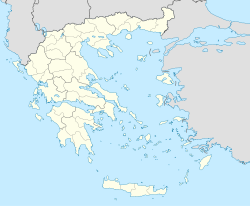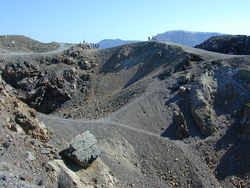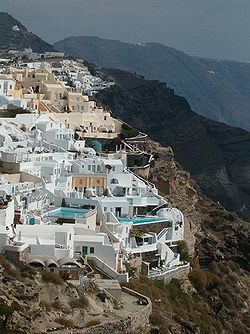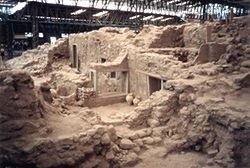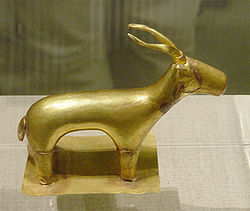- Minoan eruption
-
Minoan eruption 
Satellite image of Thera, November 21, 2000Volcano Thera Date 2nd millennium BCE Type Plinian Location Santorini, Greece
36°25′N 25°26′E / 36.417°N 25.433°ECoordinates: 36°25′N 25°26′E / 36.417°N 25.433°EVEI 6 or 7 Impact Devastated the Minoan settlements of Akrotiri and the island of Thera as well as communities and agricultural areas on nearby islands and on the coast of Crete. The Minoan eruption of Thera, also referred to as the Thera eruption or Santorini eruption, was a major catastrophic volcanic eruption with a Volcanic Explosivity Index (VEI) of 6 or 7 and a Dense-rock equivalent (DRE) of 60 cubic kilometres (14 cu mi),[1] which is estimated to have occurred in the mid second millennium BCE.[2] The eruption was one of the largest volcanic events on Earth in recorded history.[3][4][5] The eruption devastated the island of Thera (also called Santorini), including the Minoan settlement at Akrotiri, as well as communities and agricultural areas on nearby islands and on the coast of Crete.
The eruption seems to have inspired certain Greek myths[6] and may have caused turmoil in Egypt.[7][8] Additionally, it has been speculated that the Minoan eruption and the destruction of the city at Akrotiri provided the basis for or otherwise inspired Plato's story of Atlantis.[9][10]
Contents
Eruption
Background
Geological evidence shows the Thera volcano erupted numerous times over several hundred thousand years before the Minoan eruption. In a repeating process, the volcano would violently erupt, then eventually collapse into a roughly circular seawater-filled caldera, with numerous small islands forming the circle. The caldera would slowly refill with magma, building a new volcano, which erupted and then collapsed in an ongoing cyclical process.[11]
Immediately prior to the Minoan eruption, the walls of the caldera formed a nearly continuous ring of islands with the only entrance lying between Thera and the tiny island of Aspronisi.[11] This cataclysmic eruption was centered on a small island just north of the existing island of Nea Kameni in the centre of the then-existing caldera. The northern part of the caldera was refilled by the volcanic ash and lava, then collapsed again.
Magnitude
Recent research, by a team of international scientists in 2006, revealed that the Santorini event was much larger than the original estimate of 39 km3 (9.4 cu mi) of Dense-Rock Equivalent (DRE), or total volume of material erupted from the volcano, that was published in 1991.[1] With an estimated DRE in excess of 60 km3 (14 cu mi),[1][5] the volume of ejecta was approximately 100 km3 (24 cu mi),[12] placing the Volcanic Explosivity Index of the Thera eruption at 6 or 7. This was up to four times what was thrown into the stratosphere by Krakatoa in 1883, a well-recorded event. The Thera volcanic events and subsequent ashfall probably sterilized the island, as occurred on Krakatoa. Only the Mount Tambora volcanic eruption of 1815, Lake Taupo's Hatepe eruption around 180 CE, and perhaps the Baekdu Mountain eruption around 970 CE released more material into the atmosphere during historic times.[3][4]
Sequence
On Santorini, there is a 60 m (200 ft) thick layer of white tephra that overlies the soil clearly delineating the ground level prior to the eruption. This layer has three distinct bands that indicate the different phases of the eruption.[13] Studies have identified four major eruption phases, and one minor precursory tephra fall. The thinness of the first ash layer, along with the lack of noticeable erosion of that layer by winter rains before the next layer was deposited, indicate that the volcano gave the local population a few months' warning. Since no human remains have been found at the Akrotiri site, this preliminary volcanic activity probably caused the island's population to flee. It is also suggested that several months before the eruption, Santorini experienced one or more earthquakes, which damaged the local settlements.[14][15]
Intense magmatic activity of the first major phase (B01/Minoan A) of the eruption deposited up to 7 m (23 ft) of pumice and ash, with a minor lithic component, southeast and east. Archaeological evidence indicated burial of man-made structures with limited damage. The second (B02/Minoan B) and third (B03/Minoan C) eruption phases involved pyroclastic flow activity and the possible generation of tsunamis. Man-made structures not buried during Minoan A were completely destroyed. The third phase was also characterized by the initiation of caldera collapse. The fourth, and last, major phase (B04/Minoan D) was marked by varied activity: lithic-rich base surge deposits, lahars, debris flows, and co-ignimbrite ash-fall deposits. This phase was characterized by the completion of caldera collapse, which produced tsunami.[16]
Geomorphology
Although the fracturing process is not yet known, the altitudinal statistical analysis indicates that the caldera had formed just before the eruption. During this period the area of the island was smaller and the southern and eastern coastlines appeared regressed. During the eruption period the landscape was covered by the pumice sediments. In some places, the coastline vanished under thick tuff depositions, and in others recent coastlines were extended towards the sea. After the eruption, the geomorphology of the island was characterized by an intense erosional phase, during which the pumice was progressively removed from the higher altitudes towards the lower ones.[17]
Volcanology
This Plinian eruption resulted in an estimated 30 to 35 km (19 to 22 mi) high ash plume which extended into the stratosphere. In addition, the magma underlying the volcano came into contact with the shallow marine embayment, resulting in a violent steam eruption.
The eruption also generated a 35 to 150 m (115 to 490 ft) high tsunami that devastated the north coast of Crete, 110 km (68 mi) away. The tsunami had an impact on coastal towns such as Amnisos, where building walls were knocked out of alignment. On the island of Anafi, 27 km (17 mi) to the east, ash layers 3 m (10 ft) deep have been found, as well as pumice layers on slopes 250 m (820 ft) above sea level.
Elsewhere in the Mediterranean there are pumice deposits which could have been caused by the Thera eruption. Ash layers in cores drilled from the seabed and from lakes in Turkey, however, show that the heaviest ashfall was towards the east and northeast of Santorini. The ash found on Crete is now known to have been from a precursory phase of the eruption, some weeks or months before the main eruptive phases, and would have had little impact on the island.[18] Santorini ash deposits were at one time claimed to have been found in the Nile delta,[19] but this is now known to be a misidentification.[20][21]
Dating eruption
The radiocarbon dates have significant implications for the accepted chronology of Eastern Mediterranean cultures.[22][23] The Minoan eruption is a key marker for the Bronze Age archaeology of the Eastern Mediterranean world. It provides a fixed point for aligning the entire chronology of the second millennium BCE in the Aegean, because evidence of the eruption is found throughout the region. Despite this evidence, the exact date of the eruption has been difficult to determine. For most of the twentieth century, archaeologists placed it at approximately 1500 BCE,[15] but this date appeared to be too young as radiocarbon dating analysis of an olive tree buried beneath a lava flow from the volcano indicate that the eruption occurred between 1627 BCE and 1600 BCE with a 95% degree of probability.[24][25][26]
Relative chronology
Archaeologists developed the Late Bronze Age chronologies of eastern Mediterranean cultures by analyzing the origin of artifacts (for example, items from Crete, mainland Greece, Cyprus or Canaan) found in each archaeological layer.[27] If an artifact's origin can be accurately dated, then it gives a reference date for the layer in which it is found. If the Thera eruption could be associated with a given layer of Cretan (or other) culture, chronologists could use the date of that layer to date the eruption itself. Since Thera's culture at the time of destruction was similar to the Late Minoan IA (LMIA) culture on Crete, LMIA is the baseline to establish chronology elsewhere. The eruption also aligns with Late Cycladic I (LCI) and Late Helladic I (LHI) cultures, but predates Peloponnesian LHI.[28] Archeological digs on Akrotiri have also yielded fragments of nine Syro-Palestinian Middle Bronze II (MBII) gypsum vessels.[27]
The Aegean prehistorians felt so confident about their calculations that they rejected early radiocarbon dates in the 1970s for LMI/LCI Thera, because radiocarbon suggested a date about a century earlier than the "traditional" dates.[29]
At Tell el Dab'a in Egypt pumice found at this location which has been dated to 1540 B.C.E. closer to the traditionally accepted date of Thera's eruption, has been found that matches the composition of the Thera eruption.[30] This pumice has been contentious since the 1990s as it represents the most prominent supported date that differs from the old chronology. At the 6th International Symposium in 2011, however, Felix Hoeflmayer argued that "current dating differences between science and archaeology in the mid-second millennium BC. Nevertheless, the gap between science and archaeology might be narrower than previously envisaged. Radiocarbon data from the famous olive branch allows an eruption date as late as 1600 BC, whereas the recently published Bayesian model for New Kingdom Egypt would allow a rise of the reign of Ahmose up to 1570 BC on the 2σ-range. However it was argued by David Aston and others that a longer reign of Thutmose IV than used for the Bayesian model seems to be likely, opening the possibility of an even further reduced offset between radiocarbon and archaeology in the mid-second millennium BC." Thus narrowing the gap between the floating archeological chronology, and the radio-carbon chronology. Note that there is an open question on how the pumice arrived at the site, by floatation or "trading network". The latter route would cause a time lag in the dating.
Ice cores
At one time, data from Greenland ice cores seemed to support the radiocarbon dates. A large eruption identified in ice cores and dated to 1644 ± 20 BCE was suspected to be Santorini. However, volcanic ash retrieved from an ice core demonstrated that this was not from Santorini, leading to the conclusion that the eruption may have occurred on another date.[18] The late Holocene eruption of the Mount Aniakchak, a volcano in Alaska, is proposed as the most likely source of the minute shards of volcanic glass in the Greenland ice core.[31]
Tree rings
Another method used to establish the date of eruption is tree-ring dating. Tree-ring data has shown that a large event interfering with normal tree growth in North America occurred during 1629–1628 BCE.[32] Evidence of a climatic event around 1628 BCE has been found in studies of growth depression of European oaks in Ireland and of Scotch pines in Sweden.[33] Bristlecone pine frost rings also indicate a date of 1627 BCE, supporting the late 1600s BCE dating.[34][35] Procedural changes in how ice cores are interpreted would bring that data more in line with the dendrochronological numbers.[36]
Dissent
Although radiocarbon consistently indicates a 1600 BCE eruption dating, some archeologists still believe that the date is contradicted by findings in Egyptian and Theran excavations. For example, buried Egyptian and Cypriot pottery found on Thera were dated to a later period than the radiometric dates for the eruption, and, since the conventional Egyptian chronology has been established by numerous archaeological studies, the exact date of the eruption remains controversial.[37][38][39]
Climatic effects
Hydrogeologist Philip LaMoreaux asserted in 1995 that the eruption caused significant climatic changes in the eastern Mediterranean region, Aegean Sea and much of the Northern Hemisphere,[40] but this was forcefully rebutted by volcanologist David Pyle a year later.[41]
Around the time of the radiocarbon-indicated date of the eruption, there is evidence for a significant climatic event in the Northern Hemisphere. The evidence includes failure of crops in China (see below), as well as evidence from tree rings, cited above: bristlecone pines of California; bog oaks of Ireland, England, and Germany; and other trees in Sweden. The tree rings precisely date the event to 1628 BCE.[32][33]
Historical impact
Minoan civilization
The eruption devastated the nearby Minoan settlement at Akrotiri on Santorini, which was entombed in a layer of pumice.[10] It is believed that the eruption also severely affected the Minoan population on Crete, although the extent of the impact is debated. Early theories proposed that ashfall from Thera on the eastern half of Crete choked off plant life, causing starvation of the local population.[42] However, after more thorough field examinations, this theory has lost credibility, as it has been determined that no more than 5 mm (0.20 in) of ash fell anywhere on Crete.[43] Other theories have been proposed based on archeological evidence found on Crete indicating that a tsunami, likely associated with the eruption, impacted the coastal areas of Crete and may have severely devastated the Minoan coastal settlements.[44][45][46] A more recent theory is that much of the damage done to Minoan sites resulted from a large earthquake that preceded the Thera Eruption.[47]
Significant Minoan remains have been found above the Late Minoan I era Thera ash layer, implying that the Thera eruption did not cause the immediate downfall of the Minoans. As the Minoans were a sea power and depended on their naval and merchant ships for their livelihood, the Thera eruption likely caused significant economic hardship to the Minoans, and the loss of empire in the long run.[citation needed]
Whether these effects were enough to trigger the downfall of the Minoan civilization is under intense debate. The Mycenaean conquest of the Minoans occurred in Late Minoan II period, not many years after the eruption, and many archaeologists speculate that the eruption induced a crisis in Minoan civilization, which allowed the Mycenaeans to conquer them easily.[45]
Chinese records
A volcanic winter from an eruption in the late 17th century BCE has been claimed by some researchers to correlate with entries in Chinese records documenting the collapse of the Xia dynasty in China. According to the Bamboo Annals, the collapse of the dynasty and the rise of the Shang dynasty, approximately dated to 1618 BCE, were accompanied by "'yellow fog, a dim sun, then three suns, frost in July, famine, and the withering of all five cereals".[7]
Impact on Egyptian history
There are no surviving Egyptian records of the eruption, and the absence of such records is sometimes attributed to the general disorder in Egypt around the Second Intermediate Period. However, there are connections between the Thera eruption and the calamities of the Admonitions of Ipuwer, a text from Lower Egypt during the Middle Kingdom or Second Intermediate Period.[48]
Heavy rainstorms which devastated much of Egypt, and were described on the Tempest Stele of Ahmose I, have been attributed to short-term climatic changes caused by the Theran eruption.[7][8][49]
While it has been argued that the damage from this storm may have been caused by an earthquake following the Thera Eruption, it has also been suggested that it was caused during a war with the Hyksos, and the storm reference is merely a metaphor for chaos, upon which the Pharaoh was attempting to impose order.[50]
There is a consensus that Egypt, being far away from areas of significant seismic activity, would not be significantly affected by an earthquake in the Aegean. Furthermore, other documents, such as Hatshepsut's Speos Artemidos, depict similar storms, but are clearly speaking figuratively, not literally. Research indicates that this particular stele is just another reference to the Pharaoh's overcoming the powers of chaos and darkness.[50]
Greek traditions
The eruption of Thera and volcanic fallout may have inspired the myths of the Titanomachy in Hesiod's Theogony.[6] The Titanomachy could have picked up elements of western Anatolian folk memory as the tale spread westward. Hesiod's lines have been compared with volcanic activity, citing Zeus's thunderbolts as volcanic lightning, the boiling earth and sea as a breach of the magma chamber, immense flame and heat as evidence of phreatic explosions, among many other descriptions.[51]
Atlantis
Main article: Location hypotheses of AtlantisThere is some archaeological, seismological, and vulcanological evidence that the myth of Atlantis, described by Plato, is based upon the Santorini eruption.[10][44]
See also
- Timetable of major worldwide volcanic eruptions
References
- ^ a b c "Santorini eruption much larger than originally believed". University of Rhode Island. 23 August 2006. http://www.uri.edu/news/releases/?id=3654. Retrieved 2007-03-10.
- ^ Hardy DA (1989). "Therea and the Aegean World III", Volume III—Chronology (Proceedings of the Third International Congress, Hardy DA, editor). http://www.therafoundation.org/articles/chronololy/. Retrieved 2008.
- ^ a b Oppenheimer, Clive (2003). "Climatic, environmental and human consequences of the largest known historic eruption: Tambora volcano (Indonesia) 1815". Progress in Physical Geography 27 (2): 230–259. doi:10.1191/0309133303pp379ra.
- ^ a b McCoy, FW, & Dunn, SE (2002). "Modelling the Climatic Effects of the LBA Eruption of Thera: New Calculations of Tephra Volumes May Suggest a Significantly Larger Eruption than Previously Reported". Chapman Conference on Volcanism and the Earth's Atmosphere. Thera, Greece: American Geographical Union. http://www.agu.org/meetings/cc02babstracts/McCoy.pdf. Retrieved 2007-05-29.
- ^ a b Sigurdsson H, Carey, S, Alexandri M, Vougioukalakis G, Croff K, Roman C, Sakellariou D, Anagnostou C, Rousakis G, Ioakim C, Gogou A, Ballas D, Misaridis T, & Nomikou P (2006). "Marine Investigations of Greece's Santorini Volcanic Field". Eos 87 (34): 337–348. Bibcode 2006EOSTr..87..337S. doi:10.1029/2006EO340001.
- ^ a b Greene, MT (2000). Natural Knowledge in Preclassical Antiquity. Johns Hopkins University Press. ISBN 978-0-8018-6371-4.
- ^ a b c Foster, KP, Ritner, RK, and Foster, BR (1996). "Texts, Storms, and the Thera Eruption". Journal of Near Eastern Studies 55 (1): 1–14. doi:10.1086/373781.
- ^ a b EN, Davis (1990). "A Storm in Egypt during the Reign of Ahmose". Thera and the Aegean World III. Thera Foundation. http://www.therafoundation.org/articles/chronololy/astorminegyptduringthereignofahmose. Retrieved 2007-03-10.
- ^ Lilley H (2007-04-20). "The wave that destroyed Atlantis". BBC News Online. http://news.bbc.co.uk/2/hi/science/nature/6568053.stm. Retrieved 2007-04-21.
- ^ a b c Vergano, Dan (2006-08-27). "Ye gods! Ancient volcano could have blasted Atlantis myth". USA Today. http://www.usatoday.com/tech/science/columnist/vergano/2006-08-27-ancient-volcano_x.htm. Retrieved 2008-03-09.
- ^ a b Friedrich, WL (1999). Fire in the Sea, the Santorini Volcano: Natural History and the Legend of Atlantis. Cambridge University Press. ISBN 0-521-65290-1.
- ^ "Santorini - Eruptive history". Global Volcanism Program, Smithsonian Institution. http://www.volcano.si.edu/world/volcano.cfm?vnum=0102-04=&volpage=erupt. Retrieved 2009-01-01.
- ^ Davidson, DA (1979). "Aegean Soils During the Second Millennium B.C. with Reference to Thera". Thera and the Aegean World I. Papers presented at the Second International Scientific Congress, Santorini, Greece, August 1978. UK: The Thera Foundation. pp. 725–739. ISBN 0-9506133-0-4. http://www.therafoundation.org/articles/geology/aegeansoilsduringthesecondmillenniumbcwithreferencetothera. Retrieved 2007-03-10.
- ^ Gournelos, Theodoros; Evelpidou, Niki; Vassilopoulos, Andreas; Chartidou, Konstantia (2008). "Geomorphological Study of Thera". In Vassilopoulos, Andreas. Geoinformation Technologies for Geocultural Landscapes. CRC Press. p. 247. ISBN 0415468590.
* Heiken, G.; McCoy, F (1990). "Precursory Activity to the Minoan Eruption, Thera, Greece". Thera and the Aegean World III, Vol 2. London: The Thera Foundation. pp. 79–88. - ^ a b Sivertsen, Barbara J. (2009). "The Minoan Eruption". The Parting of the Sea. Princeton University Press. p. 25. ISBN 0691137706.
- ^ Savino, John; Jones, Marie D. (2007). "Aftereffects of Volcanoes". Supervolcano. Career Press. p. 88. ISBN 1564149536.
* McCoy, Floyd W.; Heiken, Grant (2000). "Tsunami Generated by the Late Bronze Age Eruption of Thera (Santorini), Greece". Pure and Applied Geophysics 157 (157): 1235–1241. Bibcode 2000PApGe.157.1227M. doi:10.1007/s000240050024. http://www.springerlink.com/content/kuu9r9ul27dqybu8/. - ^ Gournelos, T; Evelpidou, N; Vassilopolous, A; Konstantia, C (2008). "Geomorphological Study of Thera and the Akroriri Archeological Site". In A Vassilopoulos, N Evelpidou, O Bender and A Krek. Geoinformation technologies for geocultural landscapes: European perspective. CRC Press. pp. 237–54. ISBN 0415468590.
- ^ a b Keenan, Douglas J. (2003). "Volcanic ash retrieved from the GRIP ice core is not from Thera". Geochemistry Geophysics Geosystems 4 (11): 1097. Bibcode 2003GGG.....4....1K. doi:10.1029/2003GC000608. 1525-2027. http://www.informath.org/pubs/G^303a.pdf. Retrieved 2011-04-24.
- ^ Stanley, DJ & Sheng, H (1986). "Volcanic shards from Santorini (Upper Minoan ash) in the Nile Delta, Egypt". Nature 320, 1986 (6064): 733–735. Bibcode 1986Natur.320..733S. doi:10.1038/320733a0.
- ^ Guichard, F et al. (1993). "Tephra from the Minoan eruption of Santorini in sediments of the Black Sea". Nature 363 (6430): 610–612. Bibcode 1993Natur.363..610G. doi:10.1038/363610a0.
- ^ Liritzis I, Michael C, Galloway RB (1996). "A significant Aegean volcanic eruption during the second millennium BC revealed by thermoluminescence dating". Geoarchaeology 11 (4): 361–371. doi:10.1002/(SICI)1520-6548(199607)11:4<361::AID-GEA4>3.0.CO;2-#.
- ^ Balter, M (2006). "New Carbon Dates Support Revised History of Ancient Mediterranean". Science 312 (5773): 508–509. doi:10.1126/science.312.5773.508. PMID 16645054.
- ^ Wilford, JN (2006-05-09). "Ancient Crete more ancient than thought? New volcanic evidence suggests discrepancy of more than a full century". The Columbus Dispatch. http://www.columbusdispatch.com/dispatch/contentbe/dispatch/2006/05/09/20060509-D6-01.html. Retrieved 2007-05-20.
- ^ Friedrich, Walter L; Kromer, B, Friedrich, M, Heinemeier, J, Pfeiffer, T, and Talamo, S (2006). "Santorini Eruption Radiocarbon Dated to 1627-1600 B.C". Science (American Association for the Advancement of Science) 312 (5773): 548. doi:10.1126/science.1125087. PMID 16645088. http://www.sciencemag.org/cgi/content/abstract/sci;312/5773/548. Retrieved 2007-03-10.
- ^ Manning, Sturt W; Ramsey, CB, Kutschera, W, Higham, T, Kromer, B, Steier, P, and Wild, EM (2006). "Chronology for the Aegean Late Bronze Age 1700-1400 B.C". Science (American Association for the Advancement of Science) 312 (5773): 565–569. Bibcode 2006Sci...312..565M. doi:10.1126/science.1125682. PMID 16645092. http://www.sciencemag.org/cgi/content/abstract/sci;312/5773/565. Retrieved 2007-03-10.
- ^ Manning, SW (2003). "Clarifying the "high" v. "low" Aegean/Cypriot chronology for the mid second millennium BC: assessing the evidence, interpretive frameworks, and current state of the debate". In Bietak, M. The Synchronisation of Civilisations in the Eastern Mediterranean in the Second Millennium B.C. III. Proceedings of the SCIEM 2000 - 2nd EuroConference, Vienna 28th of May - 1st of June 2003. Vienna, Austria. pp. 101–137. http://dendro.cornell.edu/articles/manning2007a.pdf
- ^ a b Warren PM (1989). Summary of Evidence for the Absolute Chronology of the Early Part of the Aegean Late Bronze Age Derived from Historical Egyptian Sources in: Thera and the Aegean World III, Hardy, DA (ed). The Thera Foundation. pp. 24–26. ISBN 0-9506133-6-3. http://www.therafoundation.org/articles/chronololy/summaryofevidencefortheabsolutechronologyoftheearlypartoftheaegeanlatebronzeagederivedfromhistoricalegyptiansources. Retrieved 2007-03-10.
- ^ Lolos, YG (1989). "On the Late Helladic I of Akrotiri, Thera". The Thera Foundation. http://www.therafoundation.org/articles/chronololy/onthelatehelladiciofakrotirithera. Retrieved 2007-03-10.
- ^ Betancourt, P.P. (1984). "Dating The Aegean Late Bronze Age with Radiocarbon". Archaeometry 29 (1): 45–49. doi:10.1111/j.1475-4754.1987.tb00396.x. http://www.informath.org/apprise/a4106/b300/c1987.pdf.
- ^ Schofield, Louise (2007). The Mycenaeans. p. 69.
- ^ Pearce, N. J. G., J. A. Westgate, S. J. Preece, W. J. Eastwood, and W. T. Perkins (2004). "Identification of Aniakchak (Alaska) tephra in Greenland ice core challenges the 1645 BC date for Minoan eruption of Santorini". Geochem. Geophys. Geosyst. 5 (3): Q03005. Bibcode 2004GGG.....5.3005P. doi:10.1029/2003GC000672.
- ^ a b Baillie, MGL (1989). "Irish Tree Rings and an Event in 1628 BC". The Thera Foundation. http://www.therafoundation.org/articles/chronololy/irishtreeringandaneventin1628bc. Retrieved 2007-03-10.
- ^ a b Grudd, H, Briffa, KR, Gunnarson, BE, & Linderholm, HW (2000). "Swedish tree rings provide new evidence in support of a major, widespread environmental disruption in 1628 BC". Geophysical Research Letters 27 (18): 2957–2960. Bibcode 2000GeoRL..27.2957G. doi:10.1029/1999GL010852.
- ^ Lamarche VC, Hirschboeck KK (1984). "Frost Rings in Trees as Records of Major Volcanic Eruptions". Nature 307 (5947): 121–126. Bibcode 1984Natur.307..121L. doi:10.1038/307121a0.
- ^ Hughes MK (1988). "Ice Layer Dating of the Eruption of Santorini". Nature 335 (6187): 211–212. Bibcode 1988Natur.335..211H. doi:10.1038/335211b0.
- ^ Baillie MGL (2010). "Volcanoes, ice-cores and tree-rings: one story or two?". Antiquity 84 (323): 202–215.
- ^ "New research in Science: date of the largest volcanic eruption in the Bronze Age finally pinpointed". Aarhus University news release. 2006. http://www.nat.au.dk/default.asp?id=11296&la=UK. Retrieved 2007-03-10.
- ^ "Cornell study of ancient volcano, seeds and tree rings suggests rewriting Late Bronze Age Mediterranean history". Cornell University news release. 2006. http://www.news.cornell.edu/stories/April06/Bronze.age.AK.html. Retrieved 2007-11-17.
- ^ Warren P.M. (2006). Czerny E, Hein I, Hunger H, Melman D, Schwab A. ed. Timelines: Studies in Honour of Manfred Bietak (Orientalia Lovaniensia Analecta 149). Louvain-la-Neuve, Belgium: Peeters. pp. 2: 305–321. ISBN 90-429-1730-X.
- ^ LaMoreaux, PE (1995). "Worldwide environmental impacts from the eruption of Thera". Environmental Geology 26 (3): 172–181. Bibcode 1995EnGeo..26..172L. doi:10.1007/BF00768739.
- ^ Pyle, DM (1997). "The global impact of the Minoan eruption of Santorini, Greece". Environmental Geology 30 (1/2): 59–61. doi:10.1007/s002540050132.
- ^ Marinatos, S (1939). "The Volcanic Destruction of Minoan Crete". Antiquity 13: 425–439.
- ^ Callender, G (1999). The Minoans and the Mycenaeans: Aegean Society in the Bronze Age. Oxford University Press. ISBN 0-19-551028-3.
- ^ a b Lilley, Harvey (20 April 2007). "The wave that destroyed Atlantis". BBC Timewatch. http://news.bbc.co.uk/2/hi/science/nature/6568053.stm. Retrieved 2008-03-09.
- ^ a b Antonopoulos, J. (1992). "The great Minoan eruption of Thera volcano and the ensuing tsunami in the Greek Archipelago". Natural Hazards 5 (2): 153–168. doi:10.1007/BF00127003.
- ^ Pareschi, MT, Favalli, M & Boschi, E (2006). "Impact of the Minoan tsunami of Santorini: Simulated scenarios in the eastern Mediterranean". Geophysical Research Letters 33 (18): L1860. Bibcode 2006GeoRL..3318607P. doi:10.1029/2006GL027205..
- ^ Panagiotaki M. (2007). "The impact of the eruption of Thera in the Central Palace sanctuary at Knossos, Crete". Mediterranean Archaeology & Archaeometry 5 (2). http://www.rhodes.aegean.gr/maa_journal/issues2007b.html. Retrieved 2008-07-03.
- ^ Galanopoulos, Angelos Georgiou (1969). Atlantis: The Truth Behind the Legend. Bobbs-Merrill Co. ISBN 978-0-672-50610-9.
- ^ Goedicke, Hans (1995). Studies about Kamose and Ahmose. Baltimore: David Brown Book Company. Chapter 3. ISBN 0-9613805-8-6.
- ^ a b Wiener, MH; Allen, JP (1998). "Separate Lives: The Ahmose Tempest Stela and the Theran Eruption". Journal of Near Eastern Studies (University of Chicago Press) 57: 1–28. doi:10.1086/468596.
- ^ Luce, John Victor (1969). The end of Atlantis: New light on an old legend (New Aspects of Antiquity). London: Thames & Hudson. ISBN 978-0-500-39005-4.
Further reading
- Bietak, M (2004). "Review—'A Test of Time' by S.W. Manning (1999)". Bibliotheca Orientalis 61: 199–222. http://www.informath.org/BiOr04i.pdf. Retrieved 2008-04-21.
- Callender, G (1999). The Minoans and the Mycenaeans: Aegean Society in the Bronze Age. Oxford University Press. ISBN 0-19-551028-3.
- Forsyth, PY (1997). Thera in the Bronze Age. Peter Lang Publishing. ISBN 0-8204-4889-3.
- Friedrich, WL (1999). Fire in the Sea, the Santorini Volcano: Natural History and the Legend of Atlantis. Cambridge University Press. ISBN 0-521-65290-1.
- Warren PM (2006). "The date of the Thera eruption". In Czerny E, Hein I, Hunger H, Melman D, Schwab A. Timelines: Studies in Honour of Manfred Bietak (Orientalia Lovaniensia Analecta 149). Louvain-la-Neuve, Belgium: Peeters. pp. 2: 305–321. ISBN 90-429-1730-X.
External links
- Thera Foundation articles on archaeology, chronology, geology, volcanology, etc.
- Santorini Decade Volcano — Santorini's geology and volcanic history, the Minoan eruption and the legend of Atlantis.
- The Thera (Santorini) Volcanic Eruption and the Absolute Chronology of the Aegean Bronze Age - A WWW companion site to: Sturt W. Manning, A Test of Time: the volcano of Thera and the chronology and history of the Aegean and east Mediterranean in the mid second millennium BC.
- VolcanoWorld Information about the eruption with photographs
- Thera 2006 Expedition – exploration of the submarine deposits and morphology of Santorini volcano
- The eruption of Santorini in the Late Bronze Age – Online doctoral thesis on the eruption, scientific analyses and its environmental effects (by David A. Sewell, 2001)
Categories:- Ancient Thera
- Minoan civilization
- Volcanic events
- Volcanoes of Greece
- VEI-6 volcanoes
- VEI-7 volcanoes
Wikimedia Foundation. 2010.

